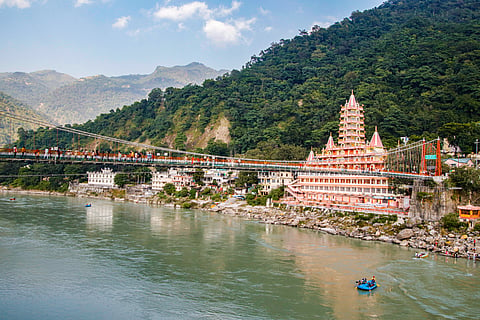
- Destinations
- Experiences
- Stay
- What's new
- Celebrating People
- Responsible Tourism
- CampaignsCampaigns
- Subscribe
- Buy Now

Rishikesh is all set to elevate its tourism landscape with the construction of Bajrang Setu, a state-of-the-art suspension bridge that promises to blend modern engineering with the city’s timeless spiritual charm.
Once completed, the bridge will serve as both a vital connectivity link and a new landmark for visitors to the Yoga Capital of the World. Designed to ease pedestrian movement and reduce congestion on the iconic Lakshman Jhula and Ram Jhula, Bajrang Setu will also offer panoramic views of the Ganga and the surrounding Himalayan foothills. With its modern design and focus on sustainability, the bridge is expected to become an iconic addition to Rishikesh’s skyline — symbolising the city’s seamless balance between heritage and progress.
A symbol of Rishikesh’s spiritual and cultural legacy, Lakshman Jhula has stood gracefully over the Ganga for nearly a century, connecting the Tapovan and Jonk villages. Opened in 1929, this iconic bridge is more than just a crossing — it’s a passage steeped in myth, history, and devotion.
According to legend, it marks the spot where Lord Lakshman once crossed the sacred river on a jute rope. For decades, pilgrims, sadhus, and travellers from around the world have walked its span, soaking in the tranquil views of the river and the temples that line its banks. Though time and wear have prompted plans for modern upgrades, Lakshman Jhula remains an enduring emblem of Rishikesh — a bridge between the ancient and the ever-evolving.
The new suspension bridge, Bajrang Setu, embodies the perfect harmony between tradition and innovation. This modern architectural marvel, inspired by the city’s timeless spiritual essence, is being built to complement — not replace — the legacy of Lakshman Jhula.
With an estimated investment of ₹60 crore, Bajrang Setu is envisioned as a 132-metre-long and 8-metre-wide marvel of modern design. Constructed using advanced materials that balance durability with visual elegance, the bridge promises to be both a functional link across the Ganga and a striking new architectural landmark for Rishikesh.
Praveen Karnwal, Executive Engineer of the Public Works Department's Narendra Nagar Division, said, "The construction of Bajrang Setu has been largely completed. About 90% of the work is done, and only the installation of glass on the pedestrian walkway remains. The bridge will be completed by December and is expected to be handed over to the administration early next year."
Bajrang Setu's most remarkable feature is its transparent glass walkways, spanning 1.5 metres wide on both sides, made from 66-mm-thick reinforced glass panels. Enabling a breathtaking view of the Ganga flowing below, these walkways promise visitors an immersive experience that blends adventure with serenity. Whether at sunrise or twilight, walking across Bajrang Setu will offer a rare perspective — where faith, nature, and modern design come together in perfect harmony.
The bridge’s central stretch will cater exclusively to two-wheelers, ensuring smooth movement across the span, while the adjoining pedestrian walkways are being engineered to accommodate heavy foot traffic with enhanced safety and stability.
Best time to visit
The best time to visit Rishikesh is from October to March. Alternatively, visiting from March to May is good for adventure sports, though it can be hotter. Avoid visiting during monsoon season (June to September).
How to get there
You can get to Rishikesh by air, by train, or by road. The closest airport is Jolly Grant Airport (DED) in Dehradun, about 35 km away, while Haridwar Railway Station is the nearest major railhead, located just 25 km from Rishikesh.
(With inputs from various sources.)
1. What is Bajrang Setu?
Bajrang Setu is a new suspension bridge being built in Rishikesh to replace the iconic Lakshman Jhula, blending modern design with traditional significance.
2. Why is Bajrang Setu being built?
It aims to ease pedestrian congestion on Lakshman Jhula and Ram Jhula while enhancing tourist experiences with panoramic views and safer infrastructure.
3. What are the features of Bajrang Setu?
The bridge spans 132 metres with an 8-metre width and includes glass walkways on both sides, offering visitors stunning views of the Ganga below.
4. When will Bajrang Setu open to the public?
Construction is nearly complete, and the bridge is expected to open by early 2026, following final installations and safety checks.
5. Where is Bajrang Setu located?
Bajrang Setu is being constructed near Lakshman Jhula in Rishikesh, Uttarakhand, serving as a new link across the Ganga River.
